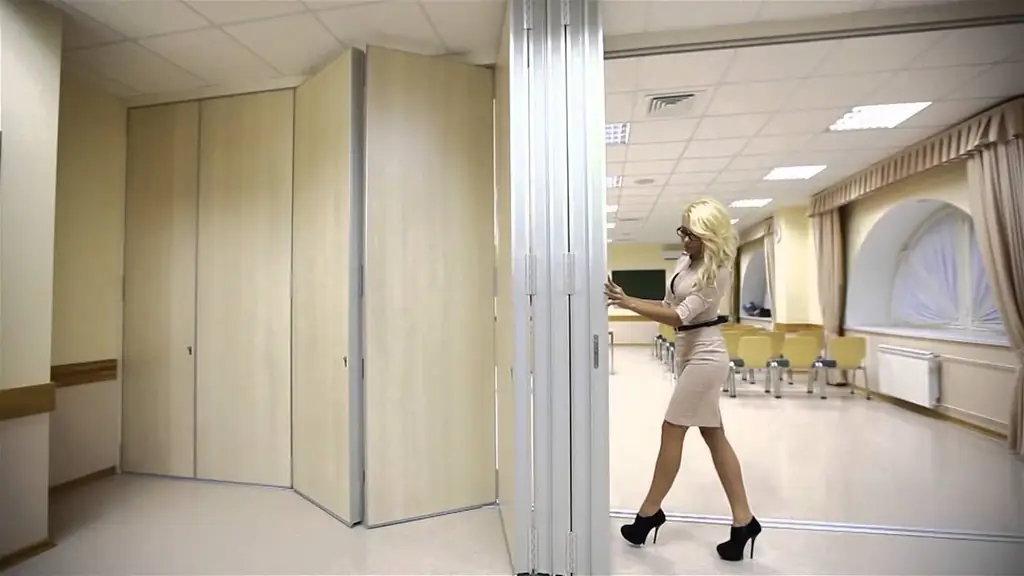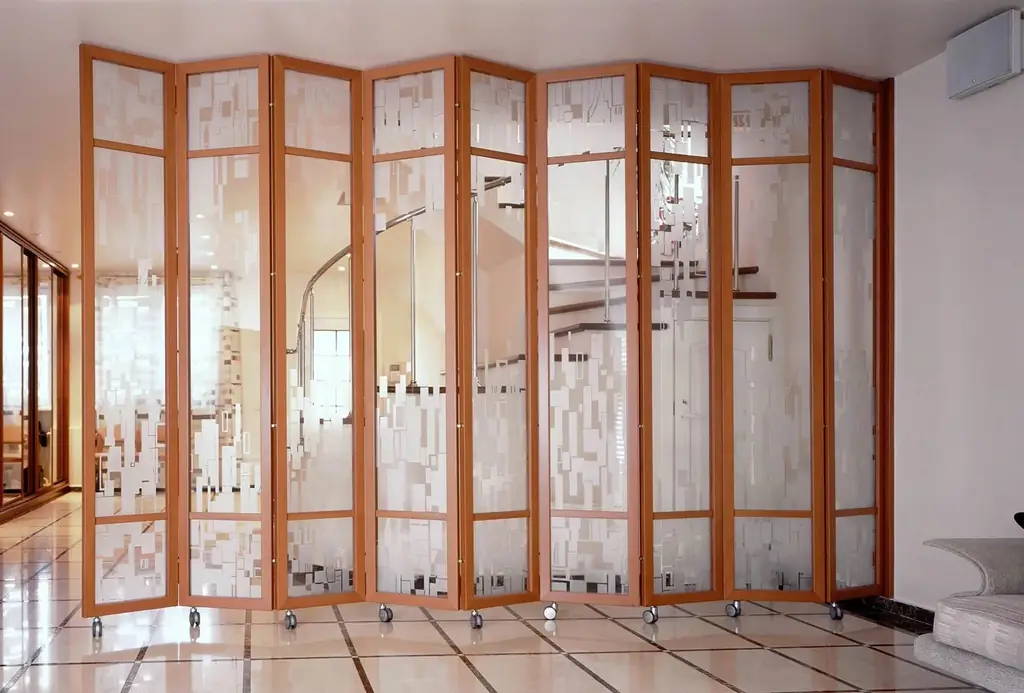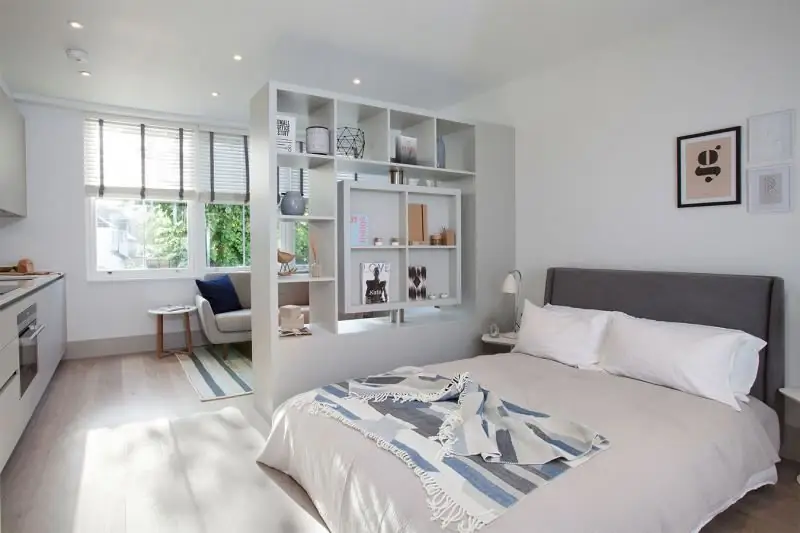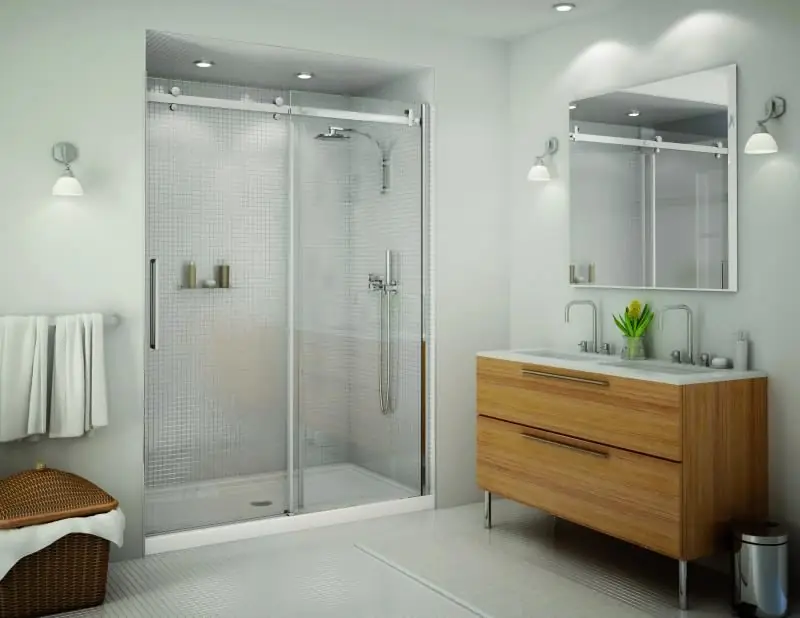
Table of contents:
- Author Bailey Albertson [email protected].
- Public 2024-01-17 22:26.
- Last modified 2025-06-01 07:32.
Glass partitions - lightness and airiness in a city apartment

Glass partitions are a modern solution to the problem of living space zoning. With the help of transparent barriers, the usable area is divided into the required number of functional zones. At the same time, natural light and visual space are preserved. The variety of designs allows you to combine the work area with a recreation area and office space. The plasticity and style of the material can satisfy the most demanding needs.
Content
- 1 In what rooms and for what purposes glass partitions are used
-
2 Types and design features
-
2.1 Basic classification
2.1.1 Photo gallery: types of glass partitions in the apartment
- 2.2 Radius glass partitions
- 2.3 Glass block partitions
-
-
3 Features of installation and decoration with your own hands
-
3.1 Installing the glass partition
3.1.1 Video: installation of a glass partition in the bathroom
-
3.2 How to fold a glass block partition
3.2.1 Video: laying glass blocks
- 3.3 DIY decor
-
In what rooms and for what purposes are glass partitions used?
They began to use glass panels as partitions since the time when they learned to make fragile glass very strong and safe. Technologically, this is achieved using two factors:
- increase in glass thickness up to 8 mm or more;
- hardening with high temperature.
As a result, we have a high-strength material that retains its structure and shape even under strong mechanical stress (impact or deformation). If, nevertheless, the glass breaks, it crumbles into many small fragments with rounded edges, unable to harm a person.
Another way to increase the strength of the glass surface is to cover it with a polymer film (on both sides). The technology is called "triplex", as glass actually has three layers. In this case, under significant mechanical stress, the glass cracks, but does not crumble, sandwiched between the elastic plastic layers.

Triplex glass has increased strength due to the use of a polymer film
In construction, both the first type and the second are used. Toughened glass has the best transparency indicators, but rather heavy. The triplex construction is light, but the film partly reduces transparency and therefore is used in places with a limited horizon of visual perception.

Tempered glass partitions are often used in offices
Today it is difficult to find the construction industry where glass partitions are not used. The purpose is very diverse. They are widely used in the organization of retail space, show rooms, offices. In industrial production, rooms separated from workshops by translucent structures are used as control centers, recreation areas and checkpoints. In housing construction, glass is used to divide the interior space of bathrooms, equip transparent corridors, and distinguish zones for various purposes.

With the help of partitions made of glass of various textures, you can divide the apartment into separate functional zones
Glass partitions are easy and quick to install. The installation does not require special equipment and personnel qualifications. An important advantage is that such structures are not considered capital structures; for redevelopment, permission and approval from the architectural services is not required.
In addition, the big advantage of glass partitions is:
- durability;
- resistance to moisture and water;
- non-susceptibility to corrosion and decay;
- immunity to biological destruction - fungus and mold will never "settle" on the glass surface.
Types and design features
Glass partitions are conventionally divided into several categories:
- by appointment;
- by the construction of the canvas;
- by the number of glasses in the panel.
Main classification
Since partitions are used in a wide range of interior solutions, according to their purpose, they are divided into:
-
Mobile. They are used in premises, the layout of which is often modified at the request of the customer. Such structures are quickly assembled and disassembled, do not leave "marks" on the floor, ceiling and walls. Fixation is done with spacer posts and threaded rods. Very convenient in offices and children's rooms. The disadvantage is the low level of sound insulation.

Glass mobile partitions After dismantling the mobile partition, it can be used in another place
-
Stationary. They are used for long-term operation. The panels are rigidly attached to the floor and ceiling surfaces and provide almost complete sound insulation.

Stationary glass partitions Stationary glass partitions can be equipped with a doorway
-
Partitions-transformers. It is a kind of hybrid design that combines the features of a fixed and mobile partition. If necessary, such devices can be folded, moved apart or retracted against the walls. There are three main types of transformers:
- sliding, equipped with a roller suspension for moving interconnected sections;
-
folding, assembling according to the principle of "accordion" or "book" and easily changing the area of the divided surface;

Folding glass partitions The advantage of folding partitions is to save valuable space
-
sliding glass walls, consisting of independent canvases, with which you can completely separate the desired room.

Sliding glass walls A sliding glass wall completely separates the seating area from the outside world
By the type of canvas, glass structures are divided into:
-
Partitions made of solid glass, consisting of monolithic panels, which are joined together at the ends. At the joints, rubber or silicone gaskets or synthetic glue are used to ensure tightness.

All-glass partition The all-glass partition is a monolithic panel
-
Frame partitions, assembled from several glasses, connected by a rigid structure made of metal, plastic or wood. One of the most common options is considered to be a frame made of aluminum profiles. The tree is used less often, exclusively for decorative purposes.

Frame partitions An aluminum profile is most often used as a frame.
And finally, the classification of partitions by the number of glasses used includes two points:
- Single glazing is the most economical option, easy to operate and maintain.
-
Double glazing is a more complex type of partition that includes not only glass panels, but also related accessories. As a rule, blinds are installed between the glasses, with the help of which the level of transparency and lighting in the room is regulated.

Double glass partitions Double glazing with shutters is used to separate the study.
Photo gallery: types of glass partitions in the apartment
-

Glass partition in the working area - Frosted glass is perfect for a study
-

Glass partition between kitchen and living room - A sliding partition separates the living room and kitchen
-

Glass partition in the recreation area - The recreation area is allocated with a glass partition
-

Bathroom divider - Glass partition - a modern alternative to the bathroom curtain
-

Partitions for dressing room - Glass partitions are ideal for highlighting the dressing room
Radial glass partitions
Curved glass partitions are becoming more and more popular. For the production of rounded sheets, the so-called bending method is used. The workpiece - even glass - is placed in special molds, where, under the influence of high temperature and pressure, the sheet softens, but does not melt. As a result, after cooling, the material acquires a given shape without losing its strength characteristics. A good example is the glass door in a glass shower stall.

The semicircular shower cubicle is very compact and harmoniously fits into any interior
Radial partitions compare favorably with flat ones with their smooth outlines and look lighter and "airier" in those places where ordinary straight lines are perceived as bulky. To install rounded structures, special fittings are required - first of all, guides for fixing to the floor and ceiling. If the partition is, moreover, sliding, and this is often practiced, to complete the assembly, you need a rail of an appropriate shape along which the roller curtain moves.

Radial glass partition expands the boundaries of space
Glass block partitions
Another common type of glass partitions is the stationary cast glass block masonry. Glass blocks come in various sizes, colors, textures and thicknesses and are glass "bricks" that are hollow inside. A wall is laid out of them according to the principle of ordinary brickwork, only instead of cement mortar, special glue for glass or ceramics is used. Glass block sizes vary from 7.5 to 10 cm, weight is 2.5-4.3 kg. This technology can be called ancient, since it dates back to the end of the 19th century (patented in 1885 by the American firm Luxfer Prism Company). Nevertheless, glass block masonry is successfully used today.

The thickness of the glass blocks allows you to equip decorative shelves inside the partitions
Features of installation and decoration with your own hands
During the self-assembly of glass partitions, as in any construction, safety measures must be observed. Installation is carried out by a team of at least two people. To install heavy glass panels, you must use special holders with suction cups and protective gloves. The presence of strangers and minor children is unacceptable.
Installation of a glass partition
For self-installation of a glass partition, you must first prepare all structural components:
- guide profiles (tracks, shaped tubes or rails);
- glass curtain travel stops;
- decorative trim (self-adhesive foil or blinds);
- rocker system (movable carriage plus bearing rollers);
- handles (end or standard sample);
- suspension brackets;
- glass panels.
Showcase glass is transported only by special vehicles with a specially equipped luggage compartment. During transportation, the panels are installed in a vertical position (in a pyramid) and tied with strong halyards.
The operating procedure does not differ from the standard installation procedure for partitions:
- The room is being prepared - the installation site must be cleared of furniture and foreign objects. The surface of the ceiling and floor is leveled, if necessary.
-
Marking and binding to the terrain is made. On the adjoining walls, vertical lines are bounced to which the edges of the partition will be attached. Use a hydraulic or laser level to check.

Marking with a laser level The laser level allows you to quickly and accurately mark for the installation of the partition
-
Guide profiles are installed along the entire perimeter. The fixation must be firm and reliable, especially if the glass is thick. Dowel-nails with a diameter of at least 6 mm are used as fasteners.

Dowel nail The greater the weight of the glass, the larger the recommended size of the dowel
- Separate sections are assembled - glass sheets are attached to the profiles. If the structure is of frame type, first the reference raster is mounted, then glass is inserted into it.
-
The sections are assembled into a single whole and fixed in an upright position.

Assembling the glass partition Before installing the glasses, the frame is mounted in a vertical position
-
If a sliding door is provided in the partition, a rocker system with a roller mechanism is installed in the place of the opening. Then the moving canvas is hung.

Installation of a sliding partition The suspension is assembled in accordance with the manufacturer's instructions.
- Preliminary tests are in progress. If a folding partition (accordion or book) is installed, a positive test result is the flawless operation of the moving mechanisms.
- Finishing work is underway to decorate the glass surface.
- Fittings are mounted - handles, locks, limiters, etc.
For different types of glass partitions, there are nuances during installation. For example, special niches (or canisters) are often built for folding structures. They are mounted from chipboard, plywood or drywall. For transformer-type partitions, holes are prepared in advance to fix the frame.
Since glass is used for arranging the partition, it is important to remember that it is almost impossible to resize the panel at home. This is especially true for tempered glass, which is not cut with a glass cutter. Therefore, at the preparatory stage, it is necessary to accurately determine the dimensions of the panels. It will not be possible to adjust the size yourself.
Video: installation of a glass partition in the bathroom
How to fold a glass block partition
The stages of assembling a partition from glass blocks are as follows:
- Marking is done - the boundaries of the partition are drawn along the walls, ceiling and floor.
-
A PVC sealing tape is glued between the glass blocks and the supporting surfaces. For this, the protective layer is removed from the tape.

Sealing tape The sealing tape increases the sound insulation of the partition
-
Laying starts from the bottom row from the wall, from left to right. The ready-made glue solution is applied to the floor and wall, its thickness is maintained from 2.5 to 3 cm.

Installation of glass blocks Depending on the conditions, the partition can be installed on the starting profile or without it
-
Special plastic crosses are inserted between the glass blocks (as when installing ceramic tiles). During laying, make sure that the solution does not come out on the front surface of the partition.

Glass brick laying In damp places, glass blocks are connected with silicone sealant
- Every 2 or 3 rows, reinforcing metal rods (with a cross section of at least 3 mm) are inserted.
- After the solution has hardened (at least 24 hours), the crosses are removed and the seams between the glass blocks are cleaned.
-
Grout is being prepared. The dry decorative mixture is diluted in clean water, following the instructions on the package. Usually the recommended ratio is 1: 1 by volume. The finished grout, brought to the consistency of thick sour cream, is used to fill the gaps between the glass blocks. After the mortar has set, excess grout is washed off with a damp sponge.

Grouting glass blocks Grouting the joints between glass blocks gives the partition a finished look
If the glass blocks are covered with a protective film, it is recommended to remove it last, after grouting the seams of the partition. This will protect the glass from accidental scratches and damage.
Video: laying glass blocks
DIY decor
In the factory, standard glass is subjected to various types of processing. Its surface is matted, making it opaque. Or a mirror layer is sprayed on and the surface reflects the light. You can order "float" - a heat-polished smooth surface with increased transparency. Or "optivayt" - a lightened version of glass with different shades. In addition, the market offers a wide range of glasses with different textures or engravings. For the most demanding customers, there is an option such as electronic regulation of the transparency of the partition - when an electric current is applied, the glass darkens or brightens.
But at home, in practice, only one type of decor is available - this is the coating of glass with decorative films. Using a simple gluing technology, the glass is given the desired texture, color or level of transparency. As a rule, the film is fixed to the surface of the partition using sweetened water and a roller. Sugar is added to the container with water at the rate of 1-2% by weight of the liquid. And with a rubber roller, air bubbles are squeezed out from under the film. It's simple.

Textured glass film simulates various surface reliefs
Glass partitions are a great way to divide space into functional areas and give your home a modern and original look. A variety of designs allows you to use them in various rooms and interiors, and installation with the proper skills is easy to do with your own hands.
Recommended:
Interior Sliding Partitions For Zoning The Space Of A Room: Design And Material Features, Their Pros And Cons, As Well As Installation Instructions, Photos

The device and purpose of interior sliding partitions. Varieties of partitions by design. Independent production and installation
Screens-partitions For Zoning Space In The Room: Varieties And Design Features, Manufacturing And Installation By Hand

What is a partition-screen. What are the types of screens, their features, advantages and disadvantages. How to make a partition screen yourself
Rack-partitions For Zoning Space In A Room: Varieties And Design Features, Installation Stages, Photo

Rack-partition: advantages and disadvantages, varieties. DIY selection and installation of multifunctional furniture
Glass Doors And Partitions For Bathroom And Shower: Types, Device, Components, Installation And Operation Features

Doors and partitions for bathroom and shower made of glass: varieties, selection of accessories. Manufacturing and installation. How to care for glass doors. Reviews
Doorbell: Main Types And Designs, Their Pros And Cons, As Well As Installation Features

Types of doorbells, their advantages and disadvantages. How to choose the right doorbell. Features of installation, dismantling and replacement
